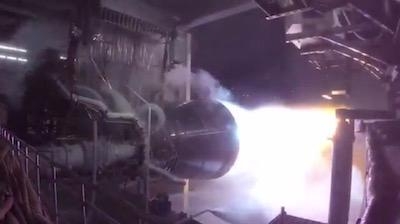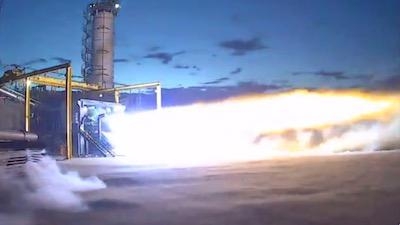Tue, Oct 24, 2017
Will Power The New Glenn Rocket, As Well As ULA Spacecraft
Blue Origin has successfully test-fired its BE-4 rocket engine at its facility in west Texas.

Geekwire reports that the engine, which is fueled by liquefied natural gas, was shipped from the manufacturing facility in Kent, WA to the test range in Texas. Jeff Bezos Tweeted on October 19 that the engine test-fire was a success.
The engine will power Blue Origin's orbital-class New Glenn rocket, which will be built at the company's factory in Florida near the Kennedy Space Center. That facility is expected to be completed by the end of the year. The New Glenn is scheduled for its first flight by 2020, and Blue Origin has already inked deals with several commercial customers for satellite launches that year. Bezos has said that he plans to bid for national security contracts, and hopes to be able to convince NASA to use the BE-4 to send spacecraft to the moon.
The company also has a contract with United Launch Alliance to supply engines for its new Vulcan rocket. That booster is expected to fly for the first time in 2019. It is designed to replace the Russian-made RD-180 engine that is currently used by some companies launching U.S. payloads into space.
The hot fire on October 19 did not reach full power, but was deemed successful nonetheless.

According to Blue Origin's website, BE-4 is the only engine that can fly by 2019, meeting the congressionally mandated deadline to eliminate dependence on Russian-built engines. The alternative engine option is multiple years behind and could not be integrated into a launch vehicle until at least 2021, extending our dependence on Russian engines well beyond 2019.
BE-4 is the only engine that can fly by 2019, meeting the congressionally mandated deadline to eliminate dependence on Russian-built engines. The alternative engine option is multiple years behind and could not be integrated into a launch vehicle until at least 2021, extending our dependence on Russian engines well beyond 2019.
(Images from video Tweeted by Jeff Bezos)
More News
Minimum Friction Level The friction level specified in AC 150/5320-12, Measurement, Construction, and Maintenance of Skid Resistant Airport Pavement Surfaces, that represents the m>[...]
Aero Linx: Airpower Museum The APM owns 30 acres on Antique Airfield, including the south half of the N-S runway. It consists of three hangars, an annex, and a library. The museum >[...]
Patient Told The First Responders That The “Man Who Was In The Plane Was Flying At The Time Of The Accident And Had Overshot The Runway They Were Attempting To Land On.&rdquo>[...]
Klyde Just Can't Believe This Has Gotten To This Point... FMI: www.klydemorris.com>[...]
Also: Duffy Wants $$$, KS Airports, Morningside U’s Aviation School, New Airstrip In ID After 6 were killed in a helicopter crash over the Hudson River, several US Representa>[...]
 ANN's Daily Aero-Term (06.02.25): Minimum Friction Level
ANN's Daily Aero-Term (06.02.25): Minimum Friction Level ANN's Daily Aero-Linx (06.02.25)
ANN's Daily Aero-Linx (06.02.25) NTSB Prelim: Champion 7ECA
NTSB Prelim: Champion 7ECA Classic Klyde Morris (From 06.10.22)
Classic Klyde Morris (From 06.10.22) Airborne 05.30.25: Anti-Helicopter Bill, PW Strike Done, All-Electric Bristell
Airborne 05.30.25: Anti-Helicopter Bill, PW Strike Done, All-Electric Bristell




